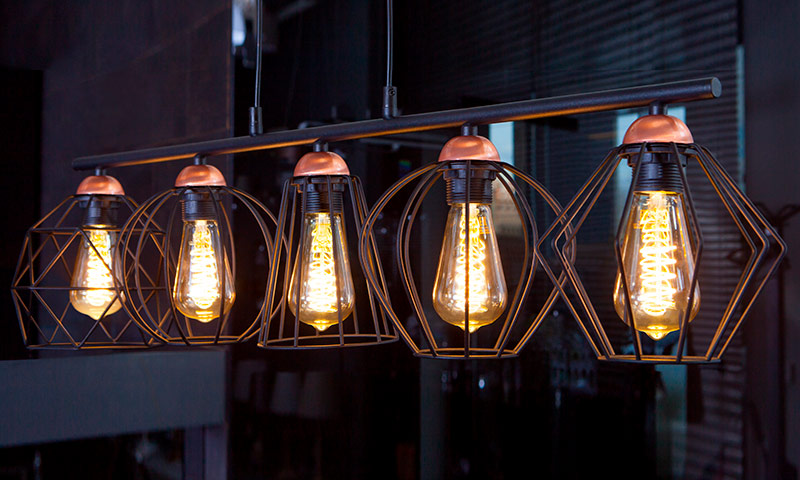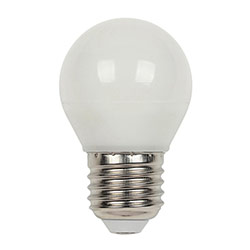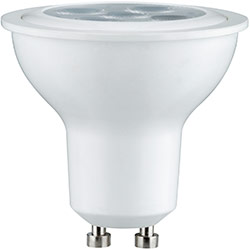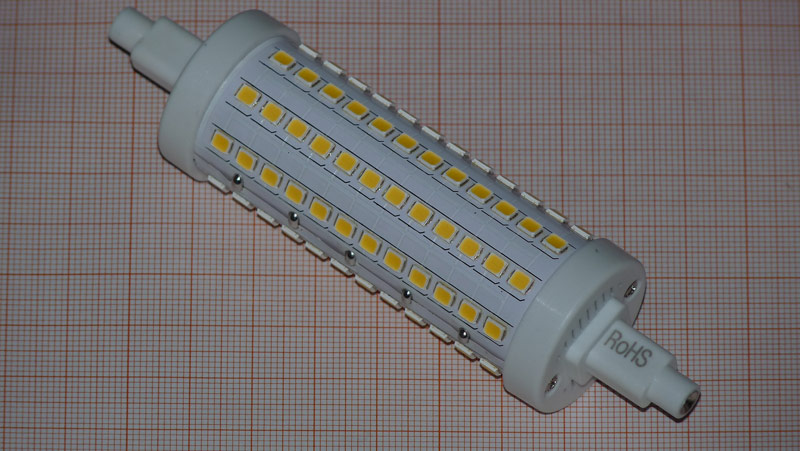Types of LED lamps for the home and their differences in LEDs, color temperature, cap and bulb shape
LED lamps are in increasing demand among consumers due to their efficiency and long life. Good light flow and the ability to withstand severe loads during use ensure the competitiveness of products in comparison with incandescent lamps.

Types of LED lamps by application
LED lamps for the home
LEDs are increasingly replacing incandescent lamps, as well as luminescent and halogen analogues. By design, they are similar to their predecessors, that is, they are a bulb on a standard base, suitable for any lamp. Used to provide lighting in rooms of any type: residential and public buildings, offices.

LED street lamps
The main purpose is to illuminate houses, illuminate streets, private areas, park and garden areas, roads, etc. Street LED lamps are produced using anti-vandal technology with a high degree of protection (IP rating). Design decisions of street LED constructions allow not only to diversify lighting, but also to give objects an aesthetic appearance.

LED lamps for plants
LED lamps (Grow light) are successfully used for growing seedlings, indoor flowers, greenhouse crops. In the manufacture of fixtures, a specially selected spectrum of radiation with ultraviolet light, which accelerates the growth and development of plants. The programming option allows for differentiated backlighting depending on operating conditions.

LED lamps for decoration
Such lamps are intended not so much for lighting as for decoration and highlighting the style of the interior. A small angle of dispersion and a wide color gamut allows you to create a cozy atmosphere and emphasize areas in the room.

LED spotlights
In the territory of private households, LED spotlights are widely used today. Due to the increased cost, until recently, such lamps were rarely used. However, with the development of technology and a decrease in prices, spotlights with a certain direction of light and a suitable angle of scattering have become more popular.

The difference in the type of LED used
In the manufacture of LED lamps, various types of LEDs can be used. Depending on the type of LED used, the technical parameters of LED lamps differ.
SMD LED Bulbs
SMD - point LEDs are LED emitters that are mounted on the surface of the substrate. A lens is mounted on top of the substrate. This type of LED is widespread due to the ability to place from one to three crystals on a substrate. The design of SMD LEDs provides good heat dissipation, which significantly extends the life of the device. In the marking after the letters SMD, four digits are used, which indicate the dimensions of the diode in millimeters.

SMD LED in an enlarged view.
COB LED Bulbs
COB - type of LEDs with crystals placed directly on the board.Emitters COB (Chip on Board) have recently become widespread in the field of household lighting. They have increased durability, reliability and good heat dissipation. A single optical system ensures uniform light output. New technologies and a reduction in the dimensions of the structure have significantly reduced the cost of the product.

Emitter with COB LEDs.
A separate type of COB includes LED filament. From which the so-called filament lamps are made. The design of filament lamps provides for the placement of a large number of filament-like LEDs on a strip coated with a phosphor. The bands can be made of metal, glass or sapphire.
The main difference from conventional diodes in which crystals are placed in separate housings is the series connection of crystals. At the same time, they are sealed in a glass or plastic tube. Thanks to the innovative design, the brightness of the glow and the scattering angle increase many times.

Filament LEDs.
The technology for the manufacture of filament lamps is still fairly new, but has broad prospects in application. Uniform dispersion of the light flux allows you to illuminate the room completely, there are no shaded areas. Externally, filament fixtures have almost no differences from traditional incandescent lamps, and many users consider this a great advantage.
In addition, high energy efficiency adds to these bulbs. At the same power as other COB lamps, filament lamps give a higher degree of illumination.

Filament lamp.
Another new solution in LED manufacturing technology is Crystal Ceramic MCOB LEDs. A large number of crystals are placed on a transparent ceramic substrate. The phosphor is applied on both sides of the substrate, which ensures uniform illumination on all sides.

Lamp with MCOB LEDs.
LED lamps depending on the color temperature of the light
Considering the types and characteristics of LED lamps, one can not stop at such a parameter as the color temperature of light. Despite the word “temperature”, this concept has absolutely nothing to do with the heat generated by the light bulb. It means the visual perception of the color spectrum of the light that the lamp emits.
Therefore, do not confuse physical and color warmth. The color temperature indicator is measured in Kelvin, which for LEDs can reach readings up to 7000 K.
Warm light

There are certain rules for choosing LED lights. Depending on the purpose of the room, lamps with suitable heat are used. For example, luminaires with a temperature in the range from 2500 to 3500 K, possessing “warm light” create a comfortable atmosphere. Yellow, similar to the light emitted by an incandescent lamp, is suitable for places of rest.
Daylight

Fluorescent lamps with temperatures in the range from 4000 to 5000K have neutral color radiation and are mainly used in workrooms. They are well suited for desktop, kitchen, bathroom.
Cold light

Lamps with temperatures above 5500 K emit the brightest cold light. Such lamps are installed in places where it is necessary to maintain an energetic state: in workshops, garages, etc. However, during prolonged exposure to cold light, you may feel tired.
Types of LED lamp bases
In LED lamps, several types of socles are used, each of which has a specific purpose.
Cap E
The most common are the universal cap "Edison", exactly repeating the connection of standard incandescent lamps. They are all threaded, but may have differences in size. The diameter is expressed in millimeters and is affixed to the lamp marking after the letter E:

E 27 - a conventional threaded base with a diameter of 27 mm. This connection is suitable for luminaires made for energy-saving or conventional incandescent lamps.

E 14 - a smaller version with a diameter of 14 mm. It is used in modern fixtures, because of their small size, such lamps are called "minions". Can be made in the form of a candle, ball, fungus.

E 40 - connection of very large sizes, used for powerful street lamps.
Cap G
Another type of cap is the pin, which are indicated by the letter G. The numbers in the name of the lamp indicate the distance between the contacts in millimeters. Sometimes after the letter G there are other signs that reflect certain features of the lamp.
For example, the letter U denotes a connector with bulges on the pins. Similar socles were used for fluorescent and halogen bulbs. The most common are the following types of socles with the marking G:

GU 10 - equipped with a two-pin connector, most often used for ceiling lighting, built-in lamps, cooker hoods.

GU 5.3 - the base is similar to the connection of halogen bulbs, equipped with two pins. Easily inserted into the cartridge, has a high degree of security. It can be powered both from a network of 220 and 12V.

G4 - has two pins, used for decorative lighting.

G9 - With this type of base, LED and fluorescent lamps are designed to replace halogen lamps. Safe and easy to install.

Gx53 - used for spot ceiling lights.
Cap R
There are socles with recessed contacts, which are marked with the Latin letter R. The number that follows the letter reflects its thickness in millimeters. Such a connection is used as a replacement for linear lamps.

LED lamps depending on the type of bulb
The variety of shapes of modern lamps allows you to choose the right types for any purpose. The most common forms of flasks are "corn", "pear", "candle."
Corn
As the name implies, the flask resembles a corncob. It has an elongated cylindrical shape, the diameter does not significantly exceed the size of the cap. Many yellow diodes are arranged on substrates in the form of a polyhedron and resemble corn kernels on the cob. The lamps have a good ability to scatter light, the angle of which can exceed 300 degrees. Such types of luminaires are used for horizontal arrangement of lamps, as well as for spot lighting with a shading lamp.
Various flask options in the form of corn



A rare type of lamp with a bulb in the shape of corn is filament lamps. The placement of threads in the cylinder provides the product with almost no advantages, but only reduces the amount of helium. At the same time, power is significantly reduced and thermal conductivity deteriorates. Therefore, a corn lamp on filament diodes can be used as a moderate point source of illumination.
Corn filament lamp options


Pear
Pear-shaped LED bulbs resemble conventional incandescent bulbs. Lamps with spot LEDs have an angle of illumination of up to 180 degrees, since all the diodes are placed on one side of the plate. Pears are used mainly for central lighting chandeliers with horns pointing down. If the cartridges are oriented to the ceiling, the lower part of the room will be shaded.
Pear Flask Options


Pear flasks are often used in filament lamps. Thanks to the dispersion of the flow by 360 degrees, the room is lit evenly, and there are almost no shaded areas. However, if you want to create a local light source, you will have to use a shade lamp to such lamps.
Pear-shaped filament lamps


Candle
LED "candle" has a limited angle of dispersion and low power. To organize central lighting, such lamps should be presented in large quantities, using a chandelier with horns pointing down. If the cartridges are facing up, then a shadow area is formed under the lamp. The best use for candles is bedside lamps or table lamps.
The shape of the flasks is diverse, it can be either simple or twisted candles, as well as imitation candles in the wind, with a bent top. The main disadvantages of such a bulb include a small power and a weak stream of light. Therefore, it is better to use them in chandeliers with a large number of rounds or for local lighting (night light, sconce, bedside lamp).
Options for the execution of a bulb in the form of a candle


Filament performance of a candle allows achieving almost the same advantages as a pear. These types of LED lighting lamps have a maximum diffusion angle and are almost universal. At the same time they are compact and safe.
Candle-shaped filament lamp options



